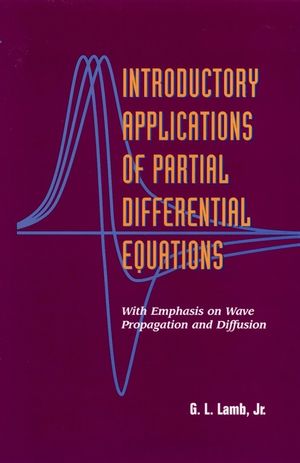Introductory Applications of Partial Differential Equations: With Emphasis on Wave Propagation and DiffusionISBN: 978-0-471-31123-2
Hardcover
496 pages
April 1995
 This is a Print-on-Demand title. It will be printed specifically to fill your order. Please allow an additional 10-15 days delivery time. The book is not returnable.
|
||||||
INTRODUCTORY APPLICATIONS OF PARTIAL DIFFERENTIAL EQUATIONS
With Emphasis on Wave Propagation and Diffusion
This is the ideal text for students and professionals who have somefamiliarity with partial differential equations, and who now wishto consolidate and expand their knowledge. Unlike most other textson this topic, it interweaves prior knowledge of mathematics andphysics, especially heat conduction and wave motion, into apresentation that demonstrates their interdependence. The result isa superb teaching text that reinforces the reader's understandingof both mathematics and physics. Rather than presenting themathematics in isolation and out of context, problems in this textare framed to show how partial differential equations can be usedto obtain specific information about the physical system beinganalyzed.
Designed for upper-level students, professionals and researchers inengineering, applied mathematics, physics, and optics, ProfessorLamb's text is lucid in its presentation and comprehensive in itscoverage of all the important topic areas, including:
* One-Dimensional Problems
* The Laplace Transform Method
* Two and Three Dimensions
* Green's Functions
* Spherical Geometry
* Fourier Transform Methods
* Perturbation Methods
* Generalizations and First Order Equations
In addition, this text includes a supplementary chapter of selectedtopics and handy appendices that review Fourier Series, LaplaceTransform, Sturm-Liouville Equations, Bessel Functions, andLegendre Polynomials.
With Emphasis on Wave Propagation and Diffusion
This is the ideal text for students and professionals who have somefamiliarity with partial differential equations, and who now wishto consolidate and expand their knowledge. Unlike most other textson this topic, it interweaves prior knowledge of mathematics andphysics, especially heat conduction and wave motion, into apresentation that demonstrates their interdependence. The result isa superb teaching text that reinforces the reader's understandingof both mathematics and physics. Rather than presenting themathematics in isolation and out of context, problems in this textare framed to show how partial differential equations can be usedto obtain specific information about the physical system beinganalyzed.
Designed for upper-level students, professionals and researchers inengineering, applied mathematics, physics, and optics, ProfessorLamb's text is lucid in its presentation and comprehensive in itscoverage of all the important topic areas, including:
* One-Dimensional Problems
* The Laplace Transform Method
* Two and Three Dimensions
* Green's Functions
* Spherical Geometry
* Fourier Transform Methods
* Perturbation Methods
* Generalizations and First Order Equations
In addition, this text includes a supplementary chapter of selectedtopics and handy appendices that review Fourier Series, LaplaceTransform, Sturm-Liouville Equations, Bessel Functions, andLegendre Polynomials.



